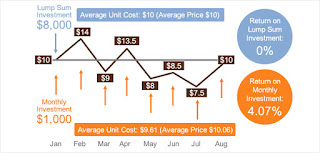Dollar-cost averaging is an integral part of DividendFarming. It’s a powerful method of growing a great financial crop. The best
part; it’s simple and automatic.
In a nutshell, dollar-cost averaging means contributing an
amount of money to your investment portfolio to purchase stock on a monthly
basis. You could also do so quarterly,
but monthly is advantageous due to the increased number of compounding
periods. The more the merrier, but I
digress. As an example, you might
purchase $100 worth of stock each month and do so irrespective of whether the
stock’s price has increased or decreased.
 |
| Courtesy of JP Morgan |
With dollar-cost averaging you may purchase a few shares at
high prices, but you are also likely to purchase more shares at lower
prices. The table below demonstrates the
principle using the $100 example mentioned previously.
Month
|
Share Price
|
Shares Purchased
|
January
|
$25
|
4
|
February
|
$28
|
3.5
|
March
|
$27
|
3.7
|
April
|
$23
|
4.3
|
May
|
$20
|
5
|
June
|
$22
|
4.5
|
TOTAL
|
25
|
You will have purchased anywhere from 3.5 to 5 shares per
month with your $100 investment as long as you were disciplined about putting
money into your brokerage account and making the purchase.
Brokerage Fees and Partial Shares
Realistically, if you were making the purchases with contributions
to your account, the stock purchase figures would be lower because you would
have paid a brokerage fee each time you made a purchase. If a broker charged you $5 for each trade,
you would be investing only $95 per month to buy stock. Consequently, the quantity of stock you buy
each month would be lower than shown.
It should also be noted you can’t buy partial shares this
way. This means another portion of
your $100 would be unavailable to use for purchases each month. This money could be held in the account and
used to supplement your purchase the following month, but you still miss the
full effect of dollar-cost averaging.
The next table offers clarity.
Month
|
Share Price
|
Commission
Fee
|
Funds
Available
|
Shares
Purchased
|
Balance
|
January
|
$25
|
$5
|
$95
|
3.0
|
$20
|
February
|
$28
|
$5
|
$95
|
3.0
|
$6
|
March
|
$27
|
$5
|
$95
|
3.0
|
$9
|
April
|
$23
|
$5
|
$95
|
4.0
|
$3
|
May
|
$20
|
$5
|
$95
|
4.0
|
$10
|
June
|
$22
|
$5
|
$95
|
4.0
|
$7
|
TOTAL
|
21
|
$56
|
In this example, which is more realistic, you would purchase
only 21 shares during the same 6-month period versus the previous case. You would contribute $30 to your broker for
the privilege of making the purchases.
An additional $56 of your $600 in investment funds accumulated in the
account because you can’t purchase partial shares.
Based on the purchase prices shown, you would have to
accumulate the leftover funds for about 3 months before you could use them to
purchase an additional share of stock.
You effectively lost $86 ($30 + $56) or 14.3% of your investment to the
broker or the opportunity-cost associated with not being fully invested each
month.
Ok, if you lose a large chunk of your investment funds in
the dollar-cost averaging example shown, how can that be beneficial to you as a
dividend farmer? When farming dividend
stocks, the dividend payments can be accepted into your brokerage account as
cash and reinvested in additional dividend stock. Managing your dividends this way results in
the kind of attrition highlighted in the second table.
DRIP Strength
However, if you have your dividend payments automatically
reinvested in the companies paying them, you avoid the brokerage fees and
you’re allowed to purchase partial shares.
When you receive $600 worth of dividends and reinvest them in a DRIP,
you put the full $600 to work for you, compounding all the way, increasing your
crop yield.
This is the true power of
dividend reinvestments. Additionally,
you’re assured of automatic contributions to your portfolio each month. Efficient, disciplined investing maximizing
your ability to grow a healthy dividend crop.
Who doesn’t like that?
The thoughts and opinions
expressed here are those of the author, who is not a financial
professional. Opinions expressed here should not be considered investment
advice. They are presented for discussion and entertainment purposes
only. For specific investment advice or assistance, please contact a
registered investment advisor, licensed broker, or other financial
professional.
No comments:
Post a Comment